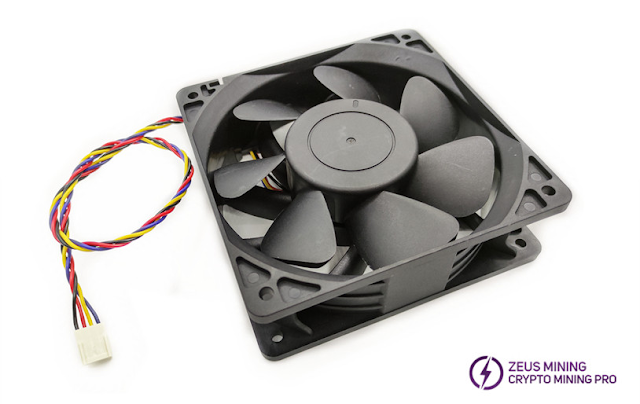Practical guide to noise control of miners
Miner noise affects sleep, physical and mental health, and the relationship between neighbors and families. However, the mining of profits cannot be stopped. So how to make a profit through mining while reducing noise? Now, let’s discuss the issue of noise reduction for miners.
Where does the miner noise come from?
ASIC miners are usually equipped with two fans, one at the air inlet and one at the air outlet, which is used to discharge the heat generated by the miner's chip and prevent the miner from being damaged due to high temperatures. The miner's fan must run at a certain speed to effectively dissipate heat, so noise is generated.
Take the Antminer S9 as an example. In normal operation, the fan speed on the mining status page is about 4320-4560 rpm, and the measured noise from 1m away is about 76dB(A), which is almost equivalent to the noise of a busy traffic hub.
(Note, the fan speed of the miner can be measured with a laser tachometer, and the noise of the mining farm can be measured with a decibel meter.)
Noise reduction methods prohibited by engineers
In terms of decibels, the noise generated by a single miner seems acceptable. But now, the mining workers usually have multiple miner rigs. In addition, all miners usually run 24/7 hours. Even if owners can pretend to be immune to noise, what about neighbors?
Therefore, the owners came up with many ideas to reduce noise. But, unfortunately, some methods are entirely wrong, for example:
Idea A: Since the noise comes from the cooling fan, why not remove the fan?
Recommendation: No. Without a cooling fan, the high temperature generated by the chip cannot be dissipated, which may cause irreversible damage to the miners. In addition, if the cooling fan is not detected, the miner will never work. If you need to remove the fan, you can install a fan speed simulator to ensure the regular operation of the miner.
Idea B: Can the fan speed be reduced arbitrarily to reduce noise?
Recommendation: No. Antminer can automatically adjust the fan speed. The fan will automatically decelerate when the ambient temperature is low, allowing the miners to run at the most suitable temperature with lower noise decibels. However, if the fan speed is arbitrarily reduced (such as replacing other low-speed fans), the heat cannot be dissipated in time, affecting the miners' operation.
Idea C: It is said that water cooling and oil cooling are also possible, so I plan to modify the miner myself.
Recommendation: Best not. Unauthorized modification may damage the precision parts inside the miner. Indeed, many computers have adopted water-cooled/oil-cooled devices to replace traditional fan cooling systems. This seems to be a new idea for miners to dissipate heat. However, none of the mainstream miners on the market currently use water-cooled/oil-cooled systems (except Antminer S9 Hydro). The reason is probably related to technical limitations. Therefore, it is recommended not to try randomly.
How to scientifically reduce the noise of miners?
In theory, there are three ways to reduce noise:
1. Reduce noise from the source.
As mentioned above, the miner fan will automatically adjust the speed. Therefore, if the miner is placed in a low-temperature environment, the fan speed will reduce noise. Therefore, the miner can choose the cooling location to place the miner.
2. Reduce the noise in sound transmission.
Many miners installed sound insulation panels and sound-absorbing cotton indoors. In addition, some are equipped with soundproof boxes for miners. These methods are usually used by people who mine at home. However, it should be noted that the indoor temperature should be adequately controlled when trying to achieve noise reduction.
3. Reduce the noise in human ears.
Wearing earplugs and earmuffs when sleeping is a good choice.
Creative noise reduction methods from customers
In addition, we also collected some creative noise reduction methods that customers came up with, as follows:
(Reminder: not verified, pay attention to it carefully).
a. Installing a sizeable soundproof cloth or soundproof board will bring good results. However, it is necessary to control the temperature because the hot air is not easy to escape from the room, so it is easy to catch fire.
b. Set up a mobile room on the roof, install soundproof cotton, and install windows and ventilating fans on the top. The effect is not that bad.
c. Several steps to reduce the noise of the miner:
1) Choose a room with two windows;
2) Separate the miners in the room with gypsum board;
3) Drill the air inlet and outlet on the gypsum board;
4) Connect the ventilation pipe with sound insulation cotton to the air outlet and the window;
5) Install a negative pressure fan at the air outlet to blow hot air out of the pipe;
6) Heat insulation boards are installed between the miners' racks to prevent heat from returning;
7) Connect the ventilation pipe to the air inlet window;
8) Keep the room door closed.
d. Pay attention to noise control from three aspects
1) Source control (place buffer materials under the miner's chassis);
2) Transmission control (under the premise of good ventilation, keep the space tightly closed or set up noise barriers around the miners);
3) Receiving end control (headphones or other self-control methods for sound insulation).

Comments
Post a Comment
Tell us your opinion